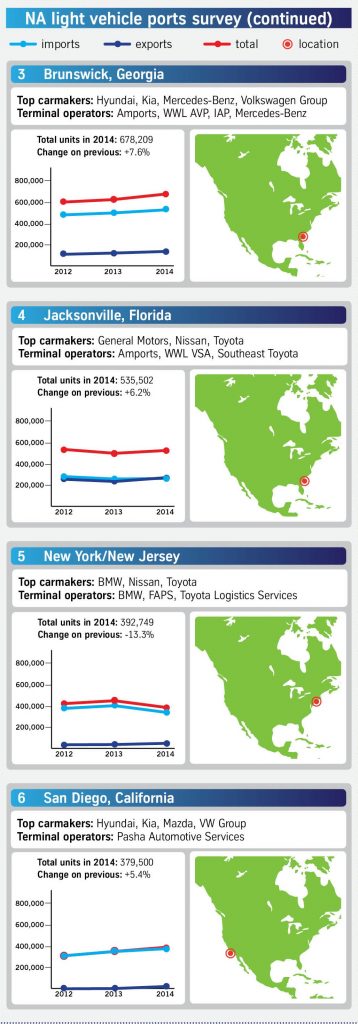North American ports: Ebbs and northbound flows
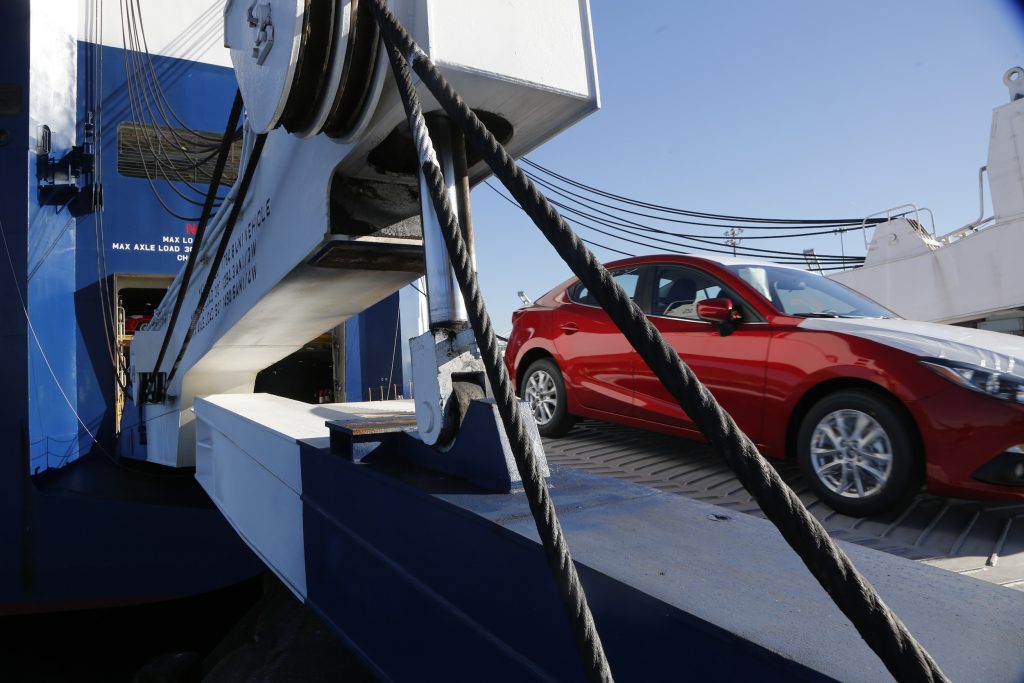 Our annual survey reveals a new port at the top of the vehicle processing table and greater growth in south-eastern ports. However, the tide can turn quickly. Christopher Ludwig contributed to this report
Our annual survey reveals a new port at the top of the vehicle processing table and greater growth in south-eastern ports. However, the tide can turn quickly. Christopher Ludwig contributed to this report
The vehicle market in North America remains on an upward track, with rising sales and increased production in both the US and Mexico. Our survey of new light-vehicle volume in North American ports reveals growth of little more than 2% in 2014 compared to the year before, with a 3% rise in US ports – but the benefits are not spread equally.
In this story...
- Local production hits imports
- Turnaround at the top
- South-eastern success
- The growing Gulf
- Wobbles in the west
- Overcoming congestion
For some traditional import centres, such as Los Angeles and Long Beach, California, and the port of New York and New Jersey, the rise in local production at the expense of imports from Japan, South Korea or Europe, for example, are starting to bite. For others, such as Baltimore, Maryland; Brunswick, Georgia; and Jacksonville, Florida, more North American production has either resulted in higher exports, or imported vehicles from Mexico.
West coast ports like Portland, Oregon and Grays Harbor, Washington, meanwhile, have seen import weaknesses offset by export growth to Asia, especially China. Charleston in South Carolina is now one of the country’s leading vehicle export ports, thanks to BMW’s plant in Spartanburg. Overall last year, export outperformed imports in our survey – albeit from a much lower base – growing by 6.8% from 2013, while imports nudged up 0.4%.
Sometimes the trend is less about regional demand and production, and more about brands. Ports like Baltimore and Jacksonville have captured luxury import brands, such as Audi, Porsche and Mercedes-Benz. Subaru’s hot streak in the US, meanwhile, has benefitted the port of Vancouver, Washington, where volume rose 17%.
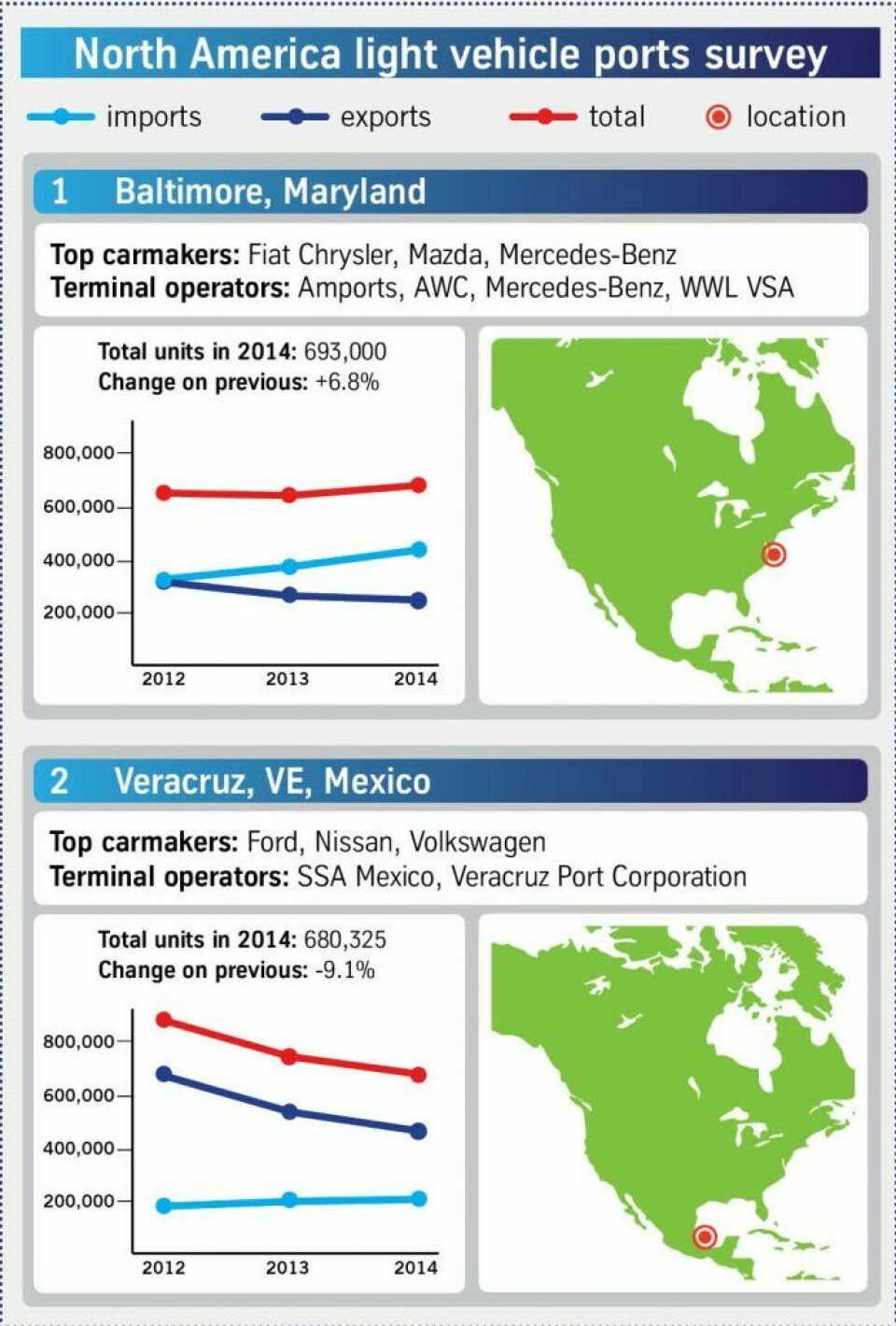
The development out of Mexico, a defining characteristic in the North American sector, is also more complex than meets the eye for port volume. The country continues to open new plants and increase exports to record levels. However, congestion and infrastructure issues have prevented some volume moving northbound by short sea. The port of Veracruz, on Mexico’s Gulf coast, which had been our survey’s top North American vehicle port since 2010, lost the crown to Baltimore this year. This drop was partly the result of fewer exports from Volkswagen, an inability to compete with rail for some trades, and because OEMs sought other options, including the west coast port of Lázaro Cárdenas.
Anticipating the growth still to come out of Mexico, as well as US population growth in the south and south-east, new terminals are being built along the Texas and Florida coasts. BMW, for example, is set to open a new terminal in Galveston, Texas with Wallenius Wilhelmsen Logistics (WWL).
Meanwhile, growth comes with inevitable challenges. In many cases, infrastructure and technology improvements have not adequately addressed port congestion problems – particularly in Mexico, but also at some US gateways. Unpredictable vessel scheduling, combined with growing ship sizes, cause vessel bunching and space shortages at major US ports. When you combine these issues with lingering difficulties in rail velocity, even mild growth in vehicle volume at North American ports may prove tough to handle.
Baltimore wins out, but Mexico gains investment
Baltimore’s rise to 693,000 units in 2014 edged out Veracruz by 13,000 vehicles. The former’s wide range of European, Japanese and US brands, including a reasonably strong export volume, continues to capture new business. Larry Johnson, automotive trade development manager at the Maryland Port Administration, says Baltimore recently began importing FCA’s Fiat 500X and Jeep Renegades from Italy, as well as the Promaster City van from Turkey beginning in November. Late last year, BMW also switched from a terminal in Baltimore, which it shared with Mercedes-Benz, to its own terminal, operated by WWL, freeing up space for both OEMs.
Baltimore has also been a staple stop out of Veracruz, currently receiving five vessel calls monthly from MOL, K-Line and Höegh Autoliners, as well as two from NYK Line. Johnson predicts imports from Mexico will increase in 2015.
Veracruz, meanwhile, slipped to second after five years on top, according to Finished Vehicle Logistics figures. The port’s volume has declined around 22% since its peak in 2012, when it handled more than 875,000 vehicles.
A number of factors contributed to Veracruz’s fall, including lower export volumes from Volkswagen in Puebla, which has seen sales drops in the US and is in the midst of several launches. Although Honda and Mazda’s new plants in Mexico use Veracruz to export to the US east coast, others have turned elsewhere. Most of Nissan’s new production in Mexico is in Aguascalientes – 850km from Veracruz – from which the carmaker ships to the US and Canada mainly by rail, although it does have several sailings by sea as well. The port’s rail link is also slow and requires switching between two railways.
Carlos Varela, director of operations at inspection specialist Unicar Mexico, says Veracruz has long had “ambitions to expand to alleviate the capacity constraints” but that funding is taking time to secure. He admits that space constraints within the port and the cost of delays for vessels waiting to offload make it “uncompetitive” compared to other eastern locations such as Altamira to the north.
Another factor that Varela points to is the weather and its effects on vehicles in transit. “Southern Mexico is affected by severe weather from the end of September to May caused by a condition known as ‘Nortes’,” he says. “This weather front propagates from the Rocky Mountains into the Gulf of Mexico resulting in cold surges and strong winds.” As a result, sea water is sprayed onto vehicles in the port, which can lead to rust. “UniCar Mexico advises on preventive measures, such as the application of temporary coverings or washing the vehicles, but these are unwelcomed additional costs that most parties responsible for the vehicles would like to avoid if possible,” observes Varela.
Some of the decline at Veracruz may also come from a shift to the west coast port of Lázaro Cárdenas, which handled a record 304,798 units last year, with exports growing more than 45% compared to 2013. Roberto Michel, chief commercial officer at SC Line, notes that several OEMs, including Honda and Nissan, switched some exports from Veracruz to Lázaro Cárdenas, including for destinations such as Columbia.
One of the issues for all ports in Mexico is that short-sea shipping services cannot currently match the frequency of rail going northbound. “One of our challenges is the lack of critical mass northbound and southbound for a dedicated short-sea shuttle service,” says Michel. “We hope that new export volumes and the development of synergies with other players for dedicated shuttle services will ease the imbalance between north and southbound flows.”
Nevertheless, Veracruz seems poised to handle more northbound volume as shipping lines add calls to ports like Brunswick and Baltimore, as well as new locations in Florida. New launches out of Puebla, as well as Audi’s upcoming plant in nearby San  José Chiapa, should also increase volume.
José Chiapa, should also increase volume.
However, both Veracruz and Lázaro Cárdenas need upgrades to handle the expected volume increases. An expansion project began last year, but there are worries it won’t happen fast enough for the expected increases, says Tomasz Lis, head of Latin America at Höegh.
There is potential for other alternatives to develop. Stanley Gabara, executive vice-president at Pasha Automotive Services, which recently increased exports from Lázaro Cárdenas to the west coast for General Motors and Honda, points to Altamira, north of Veracruz on the Gulf coast, as an “excellent” alternative.
Tomasz Lis sees potential in other ports, provided they add new facilities and inland connections. “With the proper investment, ports such as Tuxpan, Mazatlán, and Altamira will likely play an important role in the future,” he says. “Rail connectivity to Mexican ports overall will be especially important.”
The port of Tuxpan, which is located between Veracruz and Altamira on the Gulf, plans to open a new terminal in the first quarter of 2016. It is the closest port to Mexico City and it offers good highway connectivity, although currently it has no rail connection.
Of all regions in North America, south-eastern ports showed the most growth last year, rising nearly 9% compared to 2013, not least thanks to an export growth of 15%. The region’s largest port is Brunswick, which at 678,000 units fell just 2,000 behind Veracruz. Bill Jakubsen, global manager for ro-ro, bulk, and general cargo at the Georgia Ports Authority, said the route between Brunswick and Veracruz had grown increasingly important, served on inducement by ocean carriers including MOL, K-Line, and WWL. “Brunswick’s volume from Mexico is continuing to rise,” says Jakubsen.
The Georgia Ports Authority is currently expanding its rail track, while it has also been authorised for a fourth berth at the Colonel’s Island automotive terminal that will be operational in three years.
The port of Jacksonville reached 535,000 units in 2014, including a 12% jump in exports that made it a net exporter of vehicles (by a margin of 1,500 vehicles) for the first time in our survey records.
“We are aiming for balance, and in a sense we can plan for this type of ratio by meeting the demands of our long-time customers on both the import and export sides,” says Frank Camp, director of non-containerised sales.
Volkswagen is now using Jacksonville as its import hub for the south-east US, with its first shipment from Mexico arriving in April. It will also handle imports from Germany and has been handling exports from Volkswagen’s Chattanooga plant for about three years, according to Camp.
Mexico’s growth has also been a big driver for Jacksonville’s automotive business. Four carriers ship from Veracruz to the port for six calls monthly.
The port of Charleston experienced a 20% volume growth last year to nearly 237,000 units, driven mainly by strong export growth for BMWs built in Spartanburg. Along with its ro-ro trade, Charleston shipped 2,100 containerised vehicles for BMW to South America, according to Jack Ellenberg, senior vice-president of economic development and projects.
Growth out of Mexico and the south-east is creating interest along the US Gulf coast, which has traditionally handled bulk commodities, including some high-and-heavy equipment. The exception for new vehicles has been the port of Houston, where the Volkswagen Group sends volume both by rail from Mexico, as well as by vessel from Europe and Mexico. “We ship new vehicles from the port of Emden to Houston,” says Stuart Kessler manager, port operations at Houston for Volkswagen Group of America. “From Mexico, if we need to supplement rail capacity, we ship by sea from the port of Veracruz to Houston.”
Volumes in Houston should increase, especially with new Volkswagen and Audi volume from Mexico, but will be constrained by land availability, according to Stan Swigart, market development manager at the Port of Houston Authority. “Land is a big issue – there is none. Dock congestion would make ocean growth difficult,” he admits.
In response, companies are creating new options. Tomasz Lis reveals Höegh is developing a car terminal with full PDI to handle 150,000 units in Freeport, Texas, which will become operational this year. “The Freeport initiative will mainly improve lead time to the end markets instead of using large inland hauls from either east or west coast ports,” says Lis.
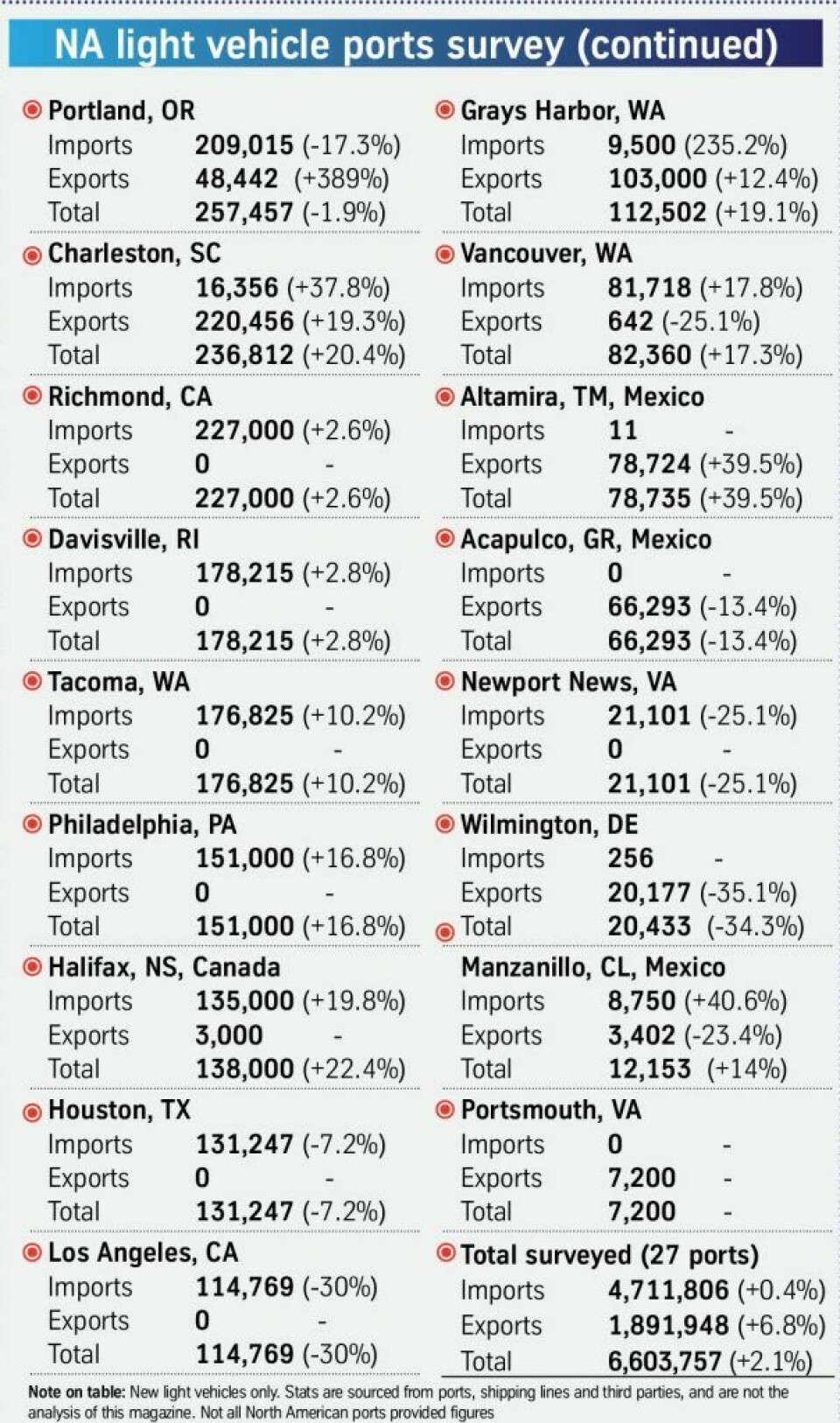
Freeport may end up competing with Galveston, where BMW and WWL have staked territory for a new facility. James Goldsmith, vehicle processing and distribution department head at BMW North America says the carmaker needed more space in its port network. “In April, we broke ground for a vehicle distribution centre at the port of Galveston that will provide faster service to dealerships in the southern region. The facilities should begin operation in early 2016,” he says. WWL has provided terminal handling at Galveston for high-and-heavy equipment for years, but the new distribution centre will be the port’s first car operation.
On Florida’s Gulf coast, Stanley Gabara says Pasha’s new ro-ro terminal at Port Manatee is also ready for operations.
“We are trying to formulate a customer base and consolidate our customers. In addition to the US, the trade region could be Mexico, South America, and Caribbean countries, including Cuba,” he says, referring to the expected normalisation of trade relations between Cuba and the US.
Longshoremen labour negotiations on the west coast, which did so much to disrupt container shipping this past winter, had surprisingly little impact on ro-ro volume at ports like Long Beach and Los Angeles. Rather, a bigger issue appears to have been the rail velocity problems that disrupted much of the North American network during the past two winters. For example, Stan Gabara says Pasha diverted 7,200 Fiat Chrysler units destined for China, South Korea and Japan from the west coast to the port of Portsmouth, Virginia. “Due to the rail meltdown last year that was caused by weather and crew shortages, it was difficult to reach the west coast [for exports]. We railed them to Portsmouth, which went well,” he relates.
Marcel van Dijk, manager of cargo marketing at the port of Los Angeles, says there were no vessel diversions during the Longshoremen dispute. Rather, the port saw declines because of diversions of production from Japan to Mexico from Nissan, the port’s sole customer. “We lost 30% of the volume in 2014 compared to 2013, which was 19% down compared to 2012. This is because Nissan has increased production in the United States, and, most recently, Mexico,” he says.
Long Beach, one of Toyota’s primary ports, showed only a slight decline; it should get a boost this year as Mercedes-Benz USA recently opened its Long Beach vehicle-processing centre, a 52-acre (21 hectare) off-port facility, which replaces its previous 14-acre terminal in Carson City. “The new facility will enable a significantly faster throughput time for vehicles,” says Ted Boudalis, strategic vehicle processing centre operations manager at the company.
Mercedes-Benz port volumes have remained relatively flat since last year, although the carmaker’s total volume in the US has increased because of production of the C-Class in Alabama that began in June 2014. “However, we predict a steady yearly increase due to market growth,” says Boudalis. The carmaker is currently building a joint-venture factory in Mexico with Nissan’s Infiniti brand.

Other ports in southern California have shown strong volume. John Demers, chief operations officer at the port of Hueneme, which handled nearly 300,000 units last year, predicts a 9% increase in volume this year for its existing customers. The Pasha-run port of San Diego has also seen rises. Richmond, California, which handles Subaru and Honda, rose 2%.
In the Pacific north-west, the largest ports lost volume last year and the smaller ones posted gains, mainly for exports. In Canada, the popularity of larger vehicles and SUVs, many of which are built in the US or Mexico, led to fewer imports at Vancouver, as those vehicles move mostly by rail.
Portland saw a fairly sharp drop in imports from Japan and South Korea, although it made up most of this volume with a rise in exports from 10,000 to 48,500 units, handling Ford exports to China. At Washington’s Grays Harbor, exports rose 12% to more than 100,000 units, mainly for Asia-bound Jeeps and other Fiat Chrysler vehicles.
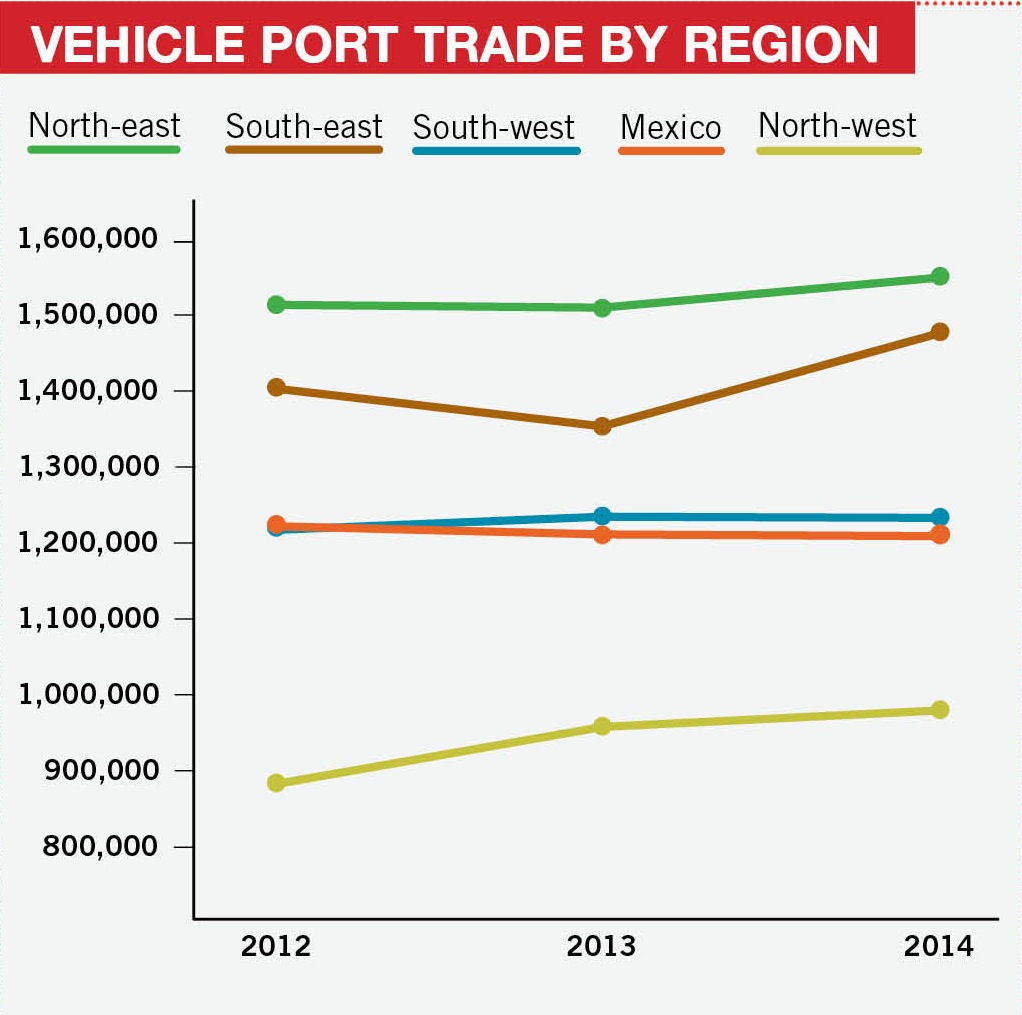
Congestion is a growing problem at ports. Andre Elmaleh, senior manager, business development for non-container at the Port of Tacoma, Washington, notices a trend towards greater vessel utilisation. “In 2014, we experienced a 4% reduction in vessel calls compared to 2013, while at the same time we received 10% more volume,” he says.
This higher volume per vessel, which is set to increase with even larger post-Panamax vessels coming into service, highlights the need for storage space. Elmaleh points to the tendency for vessels to arrive in groups, putting more stress on terminal space, even when there is excess capacity at other times. Processor AWC added 12 acres of land earlier this year to provide more ‘first point of rest’ vehicle space.
Darren Acker, national manager for port operations at Glovis America, which handles logistics for Hyundai and Kia, also notes that “vessel bunching” and the need for first-point-of-rest parking have been challenging trends. The number of days between vessel arrivals was 3.5 last year, and is now 2.4, he says. Acker adds that vessels with more than 3,000 cars have been steadily increasing over the past three years, clogging up storage and increasing the potential for ageing vehicles. “A shortage of truck and railcar capacity has also led to port congestion, which Glovis America is addressing by increasing the number of carriers it uses,” he says.
To tackle such issues, Glovis is using enhanced yard management systems to improve visibility at its ports. “These systems support our direct allocation programme, which is now beginning,” says Acker. Furthermore, last year was the first full year for the company’s Port Quality Management system, which collects vehicle quality information in real time and enables immediate responses and corrective actions.
Jim Harrington, port operations and vehicle logistics manager at Jaguar Land Rover North America, also points to the capacity issues. The British premium carmaker splits its ports of entry in the US between Baltimore (50%), Brunswick (25%), and Hueneme (25%); all JLR shipments to Canada use Halifax.
“We could benefit from more capacity and more competition – whether for ocean carriers, port processors, or inland carriers,” says Harrington. “Port processors must drive efficiency. As the automotive sector returns to full health, the ability to find and retain skilled labour is becoming difficult due to the increase in job opportunities.”
JLR has been transitioning to full transit protection against incidental damages, such as scratches and chips, that can occur in transit and delay vehicle delivery. “Our throughput has increased since we no longer need to wash every vehicle and perform detailed paint inspections. Rather, we can focus on adding port-installed options to our vehicles, which is expanding greatly,” says Harrington.
A new race begins
The vehicle sea trade in North America is in a period of transition: operators are adapting to changing production and distribution patterns, while investments (or lack thereof) in berth and inland transport links have put some ports ahead or behind. The network had plenty of double-digit swings in either direction this year, including at the top with Veracruz’s 13% drop in exports. The port of New York and New Jersey, which six years ago would have been at the top of this survey, has struggled to regain lost imports and has yet to capture significant Mexican trade, with volume down 13% last year.

Meanwhile, in contrast to Vancouver’s 7% drop, the port of Halifax grew more than 20%, with imports picking up and the launch of low volume exports from Canada to Columbia, thanks to a free trade agreement, says Mark Hallman, director of communications and public affairs at Canadian National, which operates the Autoport terminal in Halifax.
Elsewhere, ports are investing for growth. In Rhode Island, Evan Matthews, director of the port of Davisville, says processor North Atlantic Distribution added 3,250 sq.m of space that opened in May. In Vancouver, Washington AWC expanded space by 12 acres. FCA, meanwhile, has recently switched exports to the Middle East from Baltimore to the port of Wilmington, Delaware.
New terminals are coming online elsewhere, including the port of Tampa, Florida. Roberto Michel says SC Line’s sister company, Fast Terminal, is upgrading services at Port Everglades, on Florida’s south-east coast in anticipation of a new service. “The new route is a bi-weekly service to Panama and Colombia, with on-carriage to Venezuela. Shippers include BMW, Honda, and high-and-heavy manufacturers.”
While growth might be expected most in Mexico and the expanding plants of the US south, diversity in port trade shows that rises and falls happen fast. Already in 2015, the port of New York and New Jersey has seen volumes up around 35% compared to 2014 thanks to strong imports for the north-east and expanded exports. Given the quick changes in oil prices, currencies and market demand, perhaps the top vehicle port ranking will change again quickly.
